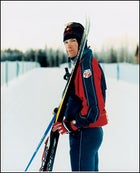IS THERE A DOWNSIDE TO HAVING 4 percent body fat spread across a frame of rippling muscle? Only if you’re looking for injection sites. “I’ve about used up the bottom two cans of my six-pack,” says Kris Freeman, a 25-year-old Olympic hopeful who makes your average Greek sculpture look like some schlub feeding off the Little Debbie rack at the Gas-N-Go. “I massage them, but the scar tissue is getting a little crunchy,” he notes. “Eventually I may have to go to my ass.”
The 2006 Winter Olympics
for �����ԹϺ��� Online’s complete coverage of the 2006 Winter Olympics, including behind-the-scene dispatches from Torino. Fast track: Freeman during training in Fairbanks.
Fast track: Freeman during training in Fairbanks.For Park City, Utah–based Freeman, the best nordic skier this country has produced in a generation, there’s no getting around the needles. The 2003 under-23 world champion now has a shot—albeit a long shot—at walking away with America’s first Olympic hardware in cross-country since Bill Koch took silver in the 30K at Innsbruck in 1976. But unless and until he does, Freeman is fated to be known as the only guy in Turin sponsored by both a ski company (Fischer) and an insulin supplier (Eli Lilly). That’s because Kris Freeman is the world’s best endurance athlete with diabetes.
Freeman grew up skiing on old boards in backwoods Andover, New Hampshire, kind of like alpine star Bode Miller. But unlike Bode, he has a talent for obscurity. In high school, Freeman excelled in the most arcane of all winter disciplines, the nordic combined—you go off the ski jump, and the guy who soars the farthest gets a lead in the cross-country race that follows. At 15, he won the 1996 junior nationals, despite starting the cross-country portion of the race four minutes behind the jumping leader. His decision, the next year, to concentrate solely on nordic skiing explains a good deal about his psyche. “One of the jumping guys tried to persuade me to stay with the program, and he’d say, ‘Those nordic guys—they never party, all they think about is training.’ And I thought, Dang, he’s talking about me.”
In 2000, with more than a dozen national titles to his name, Freeman was feeling a little logy. Blood tests revealed diabetes. To continue competing, he’d have to keep his blood sugar absolutely level. If not, well, insulin shock is a little like bonking, in the same way that flying is a little like flapping your arms. U.S. Nordic Ski Team doctor Larry Gaul recalls one 20K race last season in Sweden, when he missed handing Freeman a ten-ounce sports drink as he crested a hill halfway through the course. Freeman became “delirious,” says Gaul. “He was disoriented. He had no idea where he was.” Gaul and the other coaches now carry emergency syringes “in case we find him passed out in the snow.”
Chances are they won’t. Freeman is—in the best sense of the word—a control freak. Before a World Cup race, he likes to arrive at the course with four days to spare. “Each environment is a different stress—the altitude, the food. If I eat the exact same breakfast four days in a row, I can get the insulin dialed in.” Which is good, because on race morning, Freeman, like the rest of the field, is out testing wax, looking for an extra inch or two of glide. There’s barely time for seven or eight finger jabs to calibrate his sugar, and three or four injections to top off his insulin. All the while trying to remain calm. “Some people think being on edge helps you out, and I used to like that feeling,” says Freeman, “but adrenaline raises blood sugar, so I force myself to relax. Maybe I’ll listen to heavy metal before a race—but only a ballad.”
Unlike downhill skiing, which demands a few minutes of no-holds-barred effort, tops, a cross-country race is all about containing emotions. “It’s going as fast as you can without crossing the barrier where you put lactate in your muscles,” explains Freeman. A runner on flat ground can calculate the magic point by pace—one 5:20 mile after another and you’ve got yourself a nifty marathon. But a skier traveling up and down steep hills, and racing on ice one day and mush the next, has to be listening far more carefully to his body—especially when that skier is at risk for diabetic shock.
Eating lunch with Freeman in the cafeteria at the Olympic Training Center in Lake Placid is a lesson in spartan living: “I don’t view food as something to enjoy,” he says, spooning down some cottage cheese. “It’s just fuel. If I don’t need it, I don’t eat it.” But if you believe, as many physiologists do, that only rowers rival nordic skiers for total-body fitness, that strategy has made him one of the world’s premier athletes—and America’s biggest threat in the 15K classic in Turin.
At 25, Freeman is younger than his European rivals, including Estonia’s Andrus Veerpalu, 35, who won gold in the 15K at Salt Lake in 2002. Freeman’s only now entering the prime for endurance skiers; he should hit his peak in Vancouver four years from now. But the American insists that this year’s Games could be the moment he helps persuade his countrymen to pull those skinny skis off the garage wall and head into the woods. “I need to take a medal, because then there will be some money and some attention for the sport,” he says. “They’ve put a lot of time into us, and now it’s time for a payoff.”
Sound a little calculating? Calculating is what’s gotten him this far.


